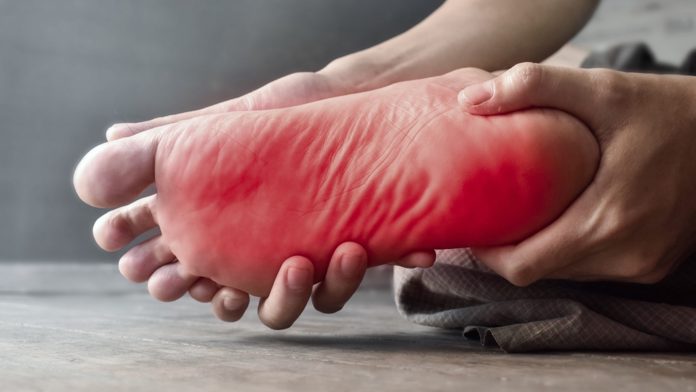
The Welsh Wound Innovation Centre’s diabetic foot clinic team share some of the challenges in treating and managing diabetes-related foot problems and some recent advances in wound care.
Several hundred million people are living with diabetes worldwide and nearly a fourth of them risk developing foot problems during their lifetime, including difficult-to-treat ulcerations. Diabetic foot ulcers pose enormous social and economic costs to healthcare systems and are strong predictors of mortality, morbidity and limb amputations in people living with diabetes. Foot ulceration and infections are common causes of prolonged hospitalisations, but though they are challenging to treat, they are very much preventable. Prevention of this much-dreaded complication requires concerted efforts at both personal and organisational levels. In this article, the WWIC’s diabetic foot clinic team discuss these challenges and address some of the commonly asked questions about diabetes and related foot complications.
What are the risk factors for developing diabetic foot ulcers?
Developing foot ulcers is a combination of reduced blood supply due to vascular disease, insensate feet due to nerve damage from neuropathy and the risk of infection due to poor blood sugar control. The risk factors can be broadly classified into:
• Those that cannot be modified e.g., age and male sex factor, the duration of diabetes, presence of vascular disease and/or neuropathy, existing foot deformities due to previous foot ulcers and
bone damage (known as Charcot’s foot), and existing kidney disease; and
• Those that can be modified e.g., smoking cessation, optimising blood sugar levels, body
weight, blood pressure and the correction of anaemia, poor vision (where possible) and
vitamin-D deficiency.
Has the prevalence of diabetic foot ulcers changed in recent years?
The International Diabetes Federation’s (IDF) Global Atlas study (2015) estimated that 415 million people are living with diabetes worldwide. The IDF further predicts a rise in prevalence to about 642 million people by 2040, accounting for nearly a tenth of the world population. Nearly a third of these 642 million people risk developing diabetic foot ulcers during their lifetimes. These studies do not account for the impact of COVID-19 lockdowns and the post-pandemic changes in work culture and lifestyle, from which subsequent data has shown that COVID-19 has had a disproportionate and negative influence on physical activity and body weight – well-known risk factors for diabetes.
How can diabetic foot problems affect people’s quality of life?
diabetic foot ulcers are significant and severe complications of diabetes and can lead to loss of life and/or limb amputations. Foot ulcers affect all aspects of life; immobility and limitations in physical ability impact daily activities, and work capabilities and some may even need carer support. Income and socioeconomic status are adversely affected due to prolonged illness, outpatient clinic visits and hospital stays. Consequently, significant proportions of people with diabetic foot ulcers have their mental health impacted by ensuing anxiety and/or depression. The strain on relationships and loss of friends and family in many cases leave patients to fend for themselves or access governmental social care. Wound odour and a lack of ability to maintain personal hygiene can also pose serious concerns for patients and their families. The offloading footwear is not particularly aesthetic and many patients find it awkward wearing them in public. On the whole, patients get entangled in a vicious cycle of physical health adversely affecting mental health and vice versa, thus affecting overall wellbeing.
What are the challenges in the management of diabetic foot ulcers?
diabetic foot ulcers pose a significant challenge to clinical management, both at a personal and organisational level. diabetic foot ulcers develop in areas of the foot subject to undue pressure such as the weight-bearing parts, and the crux of the treatment is based on offloading these ulcerated parts. Healing is impossible when patients cannot comply with offloading measures due to work requirements (e.g. metal capped boots, physical jobs etc.), the need to be on their foot to look after children, drive, attend hospital clinics and so on. The loss of foot sensations caused by diabetes-related nerve damage means the problem is not fully realised until it is too late. They may present with ulcers, sepsis and/or gangrene with 10% losing their limbs.

The loss of foot sensations caused by diabetes-related nerve damage means the problem is not fully realised until it is too late. They may present with ulcers, sepsis and /or gangrene with 10% losing their limbs
Poor mental health leads to a lack of motivation in taking prescribed medications, addressing lifestyle modifications, and attending hospital clinics. Wound care and wound dressings can be quite painful, complex procedures requiring a lot of time and effort on the patient’s part. In advanced cases where infection from the wound has spread to the underlying bone (osteomyelitis), the surgical procedures for treatment can be delayed due to poor blood sugar control.
At an organisational level, care provision for patients with diabetic foot ulcers can be extremely resource intensive. diabetic foot ulcers are unique in the sense that a standard approach of ‘one size fits all’ does not apply in its management. These chronic non-healing wounds, therefore, require a multi-disciplinary team (MDT) and a specialised approach. Having such dedicated clinics with the currently available resources is a major challenge. Reconfiguration of systems such as the centralisation of specialist services and multi-site specialities may hamper the MDT approach, delay patient transfers and management, and disrupt communication.
Healthcare systems are already struggling with a lack of resources, recruitment and manpower after the onset of the COVID-19 pandemic. Access to investigations and bespoke dressing materials/ offloading footwear is difficult in the current climate.
What can be done to minimise infection? Can you give examples of good practices in clinical infection prevention protocols?
Infections and antimicrobial resistance are other significant challenges. As part of their treatment, diabetic foot ulcer patients receive multiple courses of antibiotics and it is not uncommon for them to develop infections that are resistant to multiple antibiotics. Most hospitals and clinics will have infection prevention protocols that include meticulous hand washing, dedicated infection control beds and infection control education for the healthcare staff. These measures cannot be stringently followed sometimes due to time pressures, lack of beds etc. Enhancing infection prevention and control is the first principle in preventing antimicrobial resistance. Other principles include the prudent use of antibiotics using results from microbiological cultures, and an interdisciplinary approach using the expertise of specialists in microbiology and antibiotic use. Raising awareness equally amongst healthcare staff and patients is paramount.
What are the recent advances in wound care specific to diabetic foot ulcers?
Novel anti-diabetic medications have revolutionised the management of blood sugars and prevention of vascular complications in diabetic patients e.g., SGLT-2 inhibitors and GLP-1 analogues. In our clinical experience, we observed ulcer healing in patients treated with GLP-1 analogues. In our opinion, this merits further research to see if there are any other mechanisms involved in healing than just better sugar control and weight reduction. Newer methods of continuous blood glucose monitoring with sensor devices have also helped to better control blood sugars. Diagnostic advances to diagnose wound infection using point-of-care tests by collecting wound fluid are promising. Hand-held imaging devices that reveal most colonised/infected areas of the wound by using bacterial fluorescence are increasingly being used in clinical practice to guide treatment. Specialised dressings to manage wound moisture, deliver local antimicrobials and trap wound enzymes that prevent healing are continuously being developed and improved upon in recent times. In the last decade, there have also been advances in the practice of offloading measures. Bespoke footwear using newer materials, using thermal monitoring to detect early tissue damage and consideration of user experiences to develop better offloading measures are some to name a few. Advances in telemedicine following the pandemic can help in better monitoring patients without the need to travel to clinics and hospitals.
What can patients do to prevent diabetic foot disease?
The list of things patients can do to prevent diabetic foot disease are listed below but are not exhaustive:
• Self-educate and read foot-care information at www.diabetes.org.uk;
• Monitor blood sugars regularly as advised/indicated;
• Access preventive care in the community and at their local general practices for regular diabetic care and foot checks;
• Be proactive in asking clinicians/GPs about taking preventive medications to limit damage
from raised cholesterol, blood thinners (antiplatelet medications) for vascular disease,
drugs that protect kidneys etc.;
• Make lifestyle modifications like smoking cessation, personalised physical activity and a diet plan;
• Where possible, ask employers about workplace adaptations to reduce the risk of injury/ulceration.
Some workplaces have a ‘no trainers (footwear) policy’ and a letter from a GP or Diabetologist may enable use of prescribed footwear at work; and
• Self-purchase vitamin D from pharmacies especially during winter months, the local
pharmacist will be able to help with the correct dose.
References
- Cho NH, Shaw JE, Karuranga S, Huang Y, da Rocha Fernandes JD, Ohlrogge AW, Malanda B. IDF Diabetes Atlas: Global estimates of diabetes prevalence for 2017 and projections for 2045. Diabetes Res Clin Pract. 2018 Apr;138:271-281. doi: 10.1016/j.diabres.2018.02.023. Epub 2018 Feb 26. PMID: 29496507.
- Singh N, Armstrong DG, Lipsky BA. Preventing foot ulcers in patients with diabetes. JAMA. 2005 Jan 12;293(2):217-28. doi: 10.1001/jama.293.2.217. PMID: 15644549.
- Carr MJ, Wright AK, Leelarathna L, et al. Impact of COVID-19 restrictions on diabetes health checks and prescribing for people with type 2 diabetes: a UK-wide cohort study involving 618 161 people in primary care BMJ Quality & Safety 2022;31:503-514.
- Walsh JW, Hoffstad OJ, Sullivan MO, Margolis DJ. Association of diabetic foot ulcer and death in a population-based cohort from the United Kingdom. Diabet Med. 2016 Nov;33(11):1493-1498. doi: 10.1111/dme.13054. Epub 2016 Jan 10. PMID: 26666583.
- Bakaloudi DR, Barazzoni R, Bischoff SC, Breda J, Wickramasinghe K, Chourdakis M. Impact of the first COVID-19 lockdown on body weight: A combined systematic review and a meta-analysis. Clin Nutr. 2022 Dec;41(12):3046-3054. doi: 10.1016/j.clnu.2021.04.015. Epub 2021 Apr 20. PMID: 34049749; PMCID: PMC8056819.
- Moura LI, Dias AM, Carvalho E, de Sousa HC. Recent advances on the development of wound dressings for diabetic foot ulcer treatment–a review. Acta Biomater. 2013 Jul;9(7):7093-114. doi: 10.1016/j.actbio.2013.03.033. Epub 2013 Mar 27. PMID: 23542233.
- Crews RT, King AL, Yalla SV, Rosenblatt NJ. Recent Advances and Future Opportunities to Address Challenges in Offloading Diabetic Feet: A Mini-Review. Gerontology. 2018;64(4):309-317. doi: 10.1159/000486392. Epub 2018 Jan 16. PMID: 29402807.
Dr Mousumi Biswas
Consultant in Diabetes & Endocrinology (Aneurin Bevan University Health Board)
Melissa Blow
Prinicipal Podiatrist Diabetes & Tissue Viability (Aneurin Bevan University Health Board)
Dr Gurudutt Naik
General Practioner with interest in wound healing (Welsh Wound Innovation Centre)
https://abuhb.nhs.wales/
https://www.wwic.wales/
This article is from issue 24 of Health Europa Quarterly. Click here to get your free subscription today









